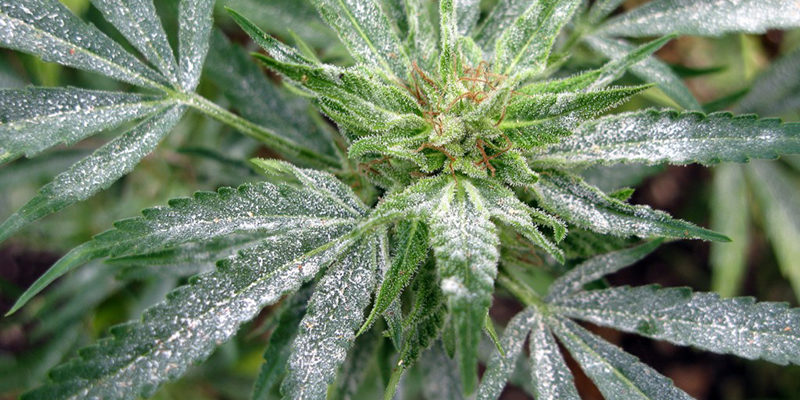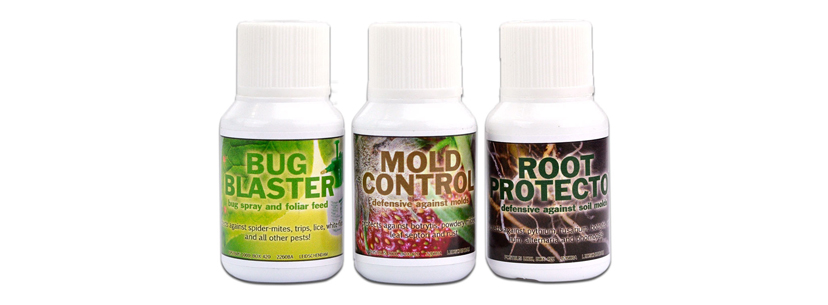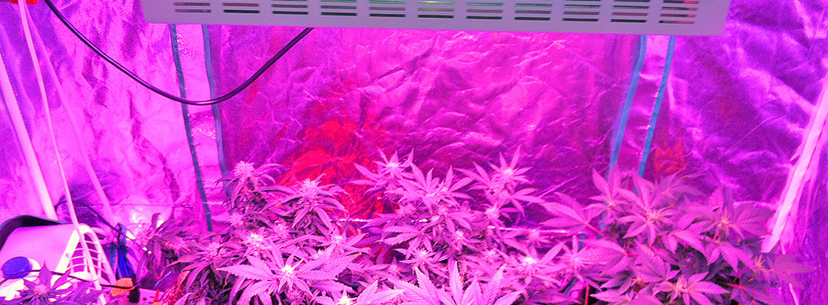Powdery mildew is one of many pests that can gravely affect marijuana plants. It is also called white powdery mildew, and it spreads and grows from a number of different types of fungi. Its name says it all: powdery mildew looks white or gray in color. It is visible as powdery growths on a marijuana plant’s leaves.
When it happens, the top parts of your marijuana plants’ leaves will begin to have little bumps on them. Powdery mildew can affect both indoor or outdoor plants. Plus, marijuana plants are not its only victim. The same species of fungi that generally attack hops also attacks marijuana.
If you want to learn all about troubleshooting during your grow, be sure to download my free Marijuana Grow Bible
Introduction to powdery mildew
White powdery mildew is extremely difficult to detect before it starts growing on your plants. That is because it can make contact with your plants in a variety of ways. It might travel via the wind with outdoor marijuana plants, or perhaps it flew into your grow room through your ventilation system. It could also be transported by pets, people, clothing, or tools.
Once the spores attach to your marijuana plants, they might not become active for a long time (until the environment is perfect for them to grow). That can make it even harder to determine how the spores got to your plants to begin with.
This is why it is critical to ensure that you are preventing the development of white powdery mildew from the start. If you aren’t concerned enough about the development of white powdery mildew to take preventative measures, you should adjust your attitude.
White powdery mildew can have extremely adverse effects on the health of your plant, including substantially slowing down the process of photosynthesis. A slow process of photosynthesis means a poor harvest, so it’s crucial that you don’t allow it to develop. It is the type of pest that isn’t terribly uncommon, meaning you should already be keeping an eye out for it before there is even any sign of it.
Recognizing powdery mildew

White powdery mildew generally develops on the leaves of marijuana plants in the form of round, fuzzy spots that resemble flour. The leaves themselves could start to wilt and get mottled in appearance, with the mold spreading quickly throughout the plant. It will destroy the parts that it reaches, so it’s very important to stop it from spreading as soon as possible.
It’s easy to identify white powdery mildew because it looks incredibly white compared to the green plant. Once you identify it, it’s important to act fast. Of course, the spores of white powdery mildew are harder (or even impossible) to spot.
Basically, if you see the leaves on your marijuana plants turning pale or having white patches, or specifically affected in one area (i.e. upper part of the plant with newer leaves, or lower part with older leaves), white powdery mildew is likely the culprit. Spots, mottled or mosaic appearance, and the wilting and drooping of your marijuana plants’ leaves are also symptoms of white powdery mildew.
If you need to identify a plant problem be sure to check out our symptom checker.
Risk factors
High humidity, whether it’s in an outdoor setting or an indoor one, is more likely to attract powdery mildew. High humidity is quantified as 55% or greater. Poor ventilation combined with high humidity is a recipe for disaster when it comes to the development of white powdery mildew.
Additional risk factors include plants’ leaves being overcrowded, meaning they are touching one another. The same goes for plants that are overcrowded with one another — if they are touching, they are too close. This means there is not enough space for air to properly ventilate through them.
Generally speaking, younger plants are at a higher risk for developing white powdery mildew. They will attack leaves, stems, and buds in equal measure. You may notice the smell of powdery mildew before you see it, especially when it is affecting the buds of your marijuana plants.
You can’t remove white powdery mildew once it has taken hold. You will simply have to remove that part of the plant, or the entire plant to prevent it from spreading to your other plants. After a while, white powdery mildew will kill off your marijuana plants — so it’s crucial that you never allow that to happen.
Getting rid of white powdery mildew

Our plant protector set definately helps.
The most important and effective way to get rid of white powdery mildew is to prevent it from happening in the first place. Pay attention to certain aspects of your grow setup, including when you first transplant your mature plants — be sure they are transplanted with plenty of extra space in between them.
Your watering schedule can also make a difference when preventing white powdery mildew from developing. For example, a good rule of thumb is to only water your marijuana plants when they have at least five hours of light afterward so they can properly dry out before night falls (or before you turn the lights off). If they aren’t given a proper chance to dry out after watering, you could end up with a moist, dark, cool environment — and that is perfect for white powdery mildew to develop.
Indoor marijuana growers can try using a UVC light to keep white powdery mildew from attacking their plants. Leaves that aren’t particularly useful, such as fan leaves that are blocked from getting direct sunlight (or artificial light) can be pruned away to make some space for air and other leaves. Using extra fans in your indoor grow setup is another excellent way to prevent white powdery mildew.
If powdery mildew is already there
If the problem is already on your marijuana plants, all is not lost. It is important to take a course of action immediately, however. Begin with a home remedy: two teaspoons of (organic) apple cider vinegar and one quart of water mixed together and put into a spray bottle. Then spray your plants with this mixture. This will not only kill the white powdery mildew that has already developed but will also stop any future spores from taking hold on your plants.
Some growers prefer to use this mixture as a preventative measure against powdery mildew. The same type of mixture can be made with half a teaspoon of baking soda mixed into a quart of water. Other sprays that work similarly are neem oil, sesame oil, or fish oil sprays. Even a mixture of two parts milk and three parts water will do the trick.
If you see a plant with a white powdery mildew issue, you need to take away the affected leaves and seal them in a plastic bag. You don’t want their spores to spread anywhere else, so a sealable bag is vital. Then begin treatment with a fungicide of some sort, particularly on the stems where the removed leaves used to grow.
Alternative methods

Other types of oil sprays are less commonly used but can also be effective. These oils sprays include clove oil, cottonseed oil, cinnamon oil, garlic oil, and coriander oil. You can also buy “Mold Control” at your local store, but for the best results, try Marijuana Mold Control.
If you mix a tablespoon of hydrogen peroxide with water, you can further destroy the fungus. The same goes for a teaspoon of limonene mixed with a quart of water — although it won’t kill the fungus completely.
Use sulfur burners to contain and keep the fungus to a minimum, but be sure to stay away from it when it’s burning. It can be harmful to people. Then wipe off any residue left in your indoor grow space, as it can continue to be harmful even after the treatment.
Some people opt for simply wiping their plants with a damp paper towel to remove the powdery mildew they can see. Just be sure not to bump or jostle the plant or leaves, because the spores could become airborne and easily spread to the neighboring plants.
Find more ways of troubleshooting during your grow on my blog or download my free Marijuana Grow Bible.
Happy growing!
Robert Bergman
www.ilovegrowingmarijuana.com
